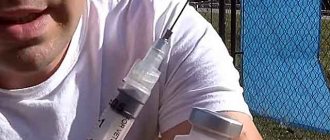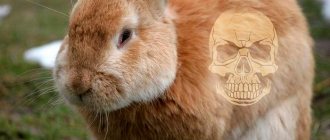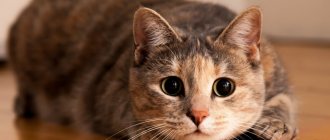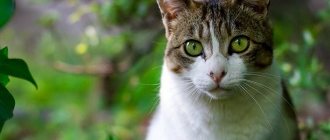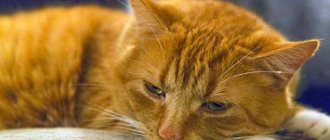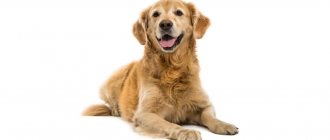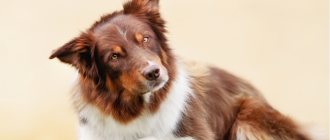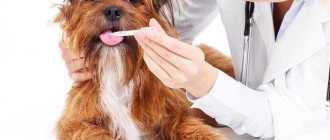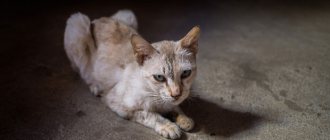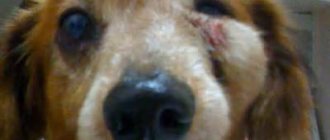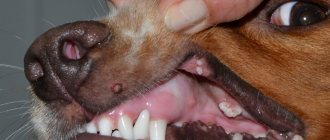Bloating is a common problem in rabbits. The digestive system of these animals is imperfect - the stomach muscles are poorly developed, food moves through the intestinal tract only through reabsorption of food. That is why any spasm or stagnation can cause the digestive system to stop functioning, resulting in unpleasant symptoms. Veterinarians call this phenomenon stasis. To help your pets get rid of this problem, you need to know what causes bloating in rabbits and what the treatment should be.
Why does this problem arise?
Before you find out what to do if your rabbit has a swollen belly, you need to understand the reasons for this phenomenon. When the intestines are blocked, severe bloating occurs, gas formation increases, and the animal’s appetite is disrupted. As a result of such negative processes, pets begin to get sick, and if left untreated, death occurs. Rabbit breeders need to figure out why this happens.
The main reasons for the appearance of stasis in the digestive system of rabbits include:
- exposure to stress, for example, if the animal is moved to a new cage or when young animals switch to solid food, if there are predators nearby - ferrets, weasels, stray dogs;
- long transportation;
- excessive amounts of fiber in the diet if rabbits eat large amounts of legumes, cabbage, alfalfa, beet tops, silage, frozen vegetables;
- deficiency in the diet of fiber, which contributes to the normal function of the digestive system;
- development and reproduction of pathogenic microorganisms in the intestinal tract;
- lack of a sufficient amount of clean drinking water in the diet - each rabbit must drink at least half a liter of water during the day, it is important to ensure that pets have constant access to a drinking bowl;
- if low-quality food and wool enter the intestinal tract, as a result of which active fermentation processes begin;
- changes in the usual microflora in the intestines;
- high humidity in the cage, too hot weather;
- diseases of the oral cavity and teeth. They often occur in adults, as a result of which food is poorly chewed and poorly absorbed in the body;
- the use of antibacterial drugs that negatively affect the microflora of the intestinal tract;
- if animals lead a sedentary lifestyle, for example, if the cage is too crowded;
- obesity.
The intestinal tract of these animals has difficulty digesting foods such as cabbage, wet grass, and legumes. Constipation in a rabbit, increased gas production or flatulence are not independent diseases. These are only the initial symptoms of dysfunction of the digestive system.
Before treating bloating in rabbits, it is necessary to determine the cause of this phenomenon. Veterinarians advise visually examining the animal and observing how it behaves.
Infection
Symptoms of bloating often occur when infectious agents enter the animal’s body. The intestinal microflora of these pets is quite unique. When they live in the wild, they will not eat harmful grass or fruits, but when kept in captivity, they are forced to eat the food that their owners give them. Therefore, rabbit breeders need to carefully monitor the quality of feed.
If an intestinal infection develops, pathogenic microorganisms, in the process of active life, begin to release specific compounds - gases. It is these compounds that become the main cause of the development of flatulence.
If proper treatment is not carried out, this can cause the development of intestinal obstruction. Therefore, even if rabbits are given high-quality food, there is no guarantee that they will be absolutely healthy. If the intestines are clogged with gases, if fluid accumulates, the animals have no appetite. In this case, death occurs from hunger.
Fermentation processes caused by specific bacteria can occur in the intestinal tract of rabbits. If these pathogens are in small quantities, they will not cause much harm to the body. But if there is an excessive amount of them, bloating will certainly appear. Such negative processes can occur if pets consume improperly dried grass.
Harvesting grass
To prevent swelling, freshly cut grass must be properly harvested. It should dry in a well-ventilated room; it should be laid out on the surface in a thin ball.
If the grass is dried in direct sun without leveling it into a thin layer, it quickly heats up and its lower layers rot. There, pathogenic microorganisms multiply, which are the main cause of fermentation processes in the stomach.
In rabbits, this problem often appears during the transition from mother's milk to adult food. A particular danger to their body is food with a lot of fiber. It can provoke the development of intestinal obstruction and severe bloating. Therefore, it is necessary that small rabbits have a small amount of cabbage, silage, legumes, beet tops, and frozen vegetables in their diet.
Clinical picture
Before you find out why rabbits become constipated and what to do about it, it is important to know how bloating develops. The presence of gastrointestinal stasis can be determined when it is in the first stages of development. Experienced rabbit breeders can easily recognize this problem in their pets.
The first thing to notice is a distended, firm belly. Beginning rabbit breeders cannot always determine the presence of a problem by eye. Therefore, you should familiarize yourself with the signs of gastrointestinal stasis:
- the rabbit refuses to eat food, becomes lethargic and depressed. This is noticeable because animals usually happily absorb the food offered;
- If flatulence or rumbling is detected, the abdomen should be palpated. Clear signs that undigested food has accumulated in the intestines, liquid and gases are present, seals near the walls of the peritoneum, rumbling or gurgling sounds are heard;
- Difficulties with defecation appear, constipation develops. If the animal does not defecate for 10 hours, the amount of feces decreases significantly or they change color. This indicates possible problems with the gastrointestinal tract;
- body temperature indicators are reduced - up to 37 degrees;
- breathing becomes rapid;
- teeth grinding occurs.
Rabbit breeders use a stethoscope to examine their pets. It helps to auscultate the stomach and intestines and hear characteristic sounds.
If disturbances in the digestive system are severe, animals suffer from pain. When the walls of the intestinal tract expand, compression of the diaphragm occurs, so you need to pay attention to your breathing.
Evidence of the development of infectious processes in the gastrointestinal tract are the following signs: impurities or clots of mucus or blood, prolonged diarrhea. In this case, it is important to visit a veterinarian as soon as possible.
Signs and symptoms of the disease
It is important to recognize the problem in time, because often the farmer does not have much time to help his pets. Rabbits swell and die in a matter of hours if treatment is not started on time. This happens because gases accumulated in the intestines put strong pressure on the diaphragm.
Signs of pathology
Because of this, the animal cannot breathe normally. It dies from lack of oxygen. Let's look at the signs of the disease:
- Round belly, rumbling, hardening of the intestines.
- Loss of appetite or complete refusal to eat.
- Oppression.
- Grinding of teeth.
- Delayed defecation.
- Reducing pea-sized stool.
- Changes in the color of stool and its consistency.
- Paleness of the mucous membranes (this symptom indicates a lack of oxygen in the blood).
Attention! Infectious diseases may cause fever, diarrhea and bloating, thirst, and exhaustion. With liver coccidiosis, visible mucous membranes become yellow.
First aid
If rabbit breeders detect clinical signs of existing eating disorders, first aid must be provided:
- isolate the sick pet from its relatives, transplant it to a separate room;
- conduct a detailed external examination, while carefully palpating the abdomen.
After the examination and confirmation of the guess about the development of stasis, it is necessary to carry out appropriate treatment. Therapy for this disease is carried out using medications and alternative means.
First aid for your pet is to stimulate its physical activity. Next, he needs to be given a decoction of dill. This will help get rid of gases that have accumulated in abundance in the intestines.
Do not give food until the condition improves. To maintain the vitality of the animal, it is injected with glucose.
Important! Under no circumstances should you apply a cold or hot heating pad. This can provoke an increase in fermentation processes.
What to do if your stomach growls
Treatment for this symptom will depend on the identified cause. In some cases, it is enough to simply adjust your diet and diet.
Food hygiene
To ensure that stomach turmoil bothers you as little as possible, try to follow the advice of gastroenterologists:
- Don't eat too quickly and swallow large pieces. Air enters the stomach along with them.
- Try to eat regularly so that the gaps between meals are not too long. Don't skip a light dinner. Many people who do not eat after 6 pm complain of stomach rumbling at night.
- Don't overeat. It is better to eat more often, but in small portions.
- Avoid foods that are difficult to digest: fatty meats, lard, coarse-fiber vegetables, and baked goods.
- If possible, heat-treat vegetables.
- Limit the consumption of foods that increase gas formation.
Drug treatment
Doctor's prescriptions are primarily aimed at eliminating the source of the disease, but symptomatic therapy is also important. We list the medications that help get rid of rumbling.
- Espumisan is a drug that reduces gas formation in the digestive tract. It seems to “collapse” the air bubbles in the intestines.
- Antispasmodics (drotaverine, duspatalin, buscopan) relax the intestinal wall and prevent stagnation of food due to spasm.
- Enzyme agents (festal, creon, panzinorm) speed up the digestion of food and prevent rotting processes in the stomach and intestines.
- Prokinetics (itomed, motilak) normalize the motor activity of the digestive tube during inflammatory processes and functional disorders.
- Enterosorbents (polysorb, activated carbon, polyphepan) are agents that combine with bacterial toxins, gas bubbles and remove them from the body.
- Prebiotics and probiotics normalize the composition of intestinal microflora. Probiotics (Linex, Bifiform) contain live cultures of beneficial bacteria that gradually colonize the digestive tract. Prebiotics contain substances (inulin, lactulose) that stimulate the growth and reproduction of normal microflora.
Additional treatments
Eating fermented milk products helps populate the intestines with bifidobacteria and lactobacilli, which are necessary for the complete digestion of food.
Mineral waters improve digestion and gastrointestinal motility, but you need to select them depending on the level of acidity of the stomach and drink only after all the gas has come out of the liquid.
Herbal mixtures based on chamomile, sage, plantain, and nettle also improve the condition. They need to be brewed and drunk before meals 3 times a day.
To normalize gastrointestinal motility, sufficient physical activity is important. Regular exercise improves the elimination of gases and prevents rumbling in the stomach. Just don’t exercise after eating - this can trigger the development of reflux.
Rumbling is a common symptom that usually does not cause discomfort to people. But if this problem begins to seriously complicate life, you need to think about its possible causes, undergo a medical examination and select appropriate therapy.
The drug Espumisan
It contains simethicone, which releases gas bubbles from the intestines. With the help of Espumisan, you can partially get rid of bloating, and it will become easier for your rabbit to breathe. This is a good help and prevents intestinal rupture.
The drug is administered using a pipette. This procedure must be repeated at intervals of three hours. Dosage of the drug – per 1 kg of live body weight you need to take 20 drops.
Activated carbon
You need to crush an activated carbon tablet, mix it with a small amount of warm water and give it to the animal to drink. Adults can take not one tablet, but two. If the animal refuses to drink, you need to force the solution into its mouth using an insulin syringe without a needle.
Simethicone can be given to your pets at intervals of one hour; it will relieve gases from the digestive tract.
How to properly treat bloating in a rabbit
If digestive problems are detected, experienced farmers advise adhering to the following system of behavior:
- It is important to place the sick individual separately - this will prevent possible infection of healthy pets.
- The animal is grabbed under the front legs and placed on its back with its head facing you, after which the tummy is palpated and massaged. All manipulations with the rabbit are carried out only after it has calmed down, when the pet stops breaking out of your hands and getting nervous.
- If the abdominal cavity is really swollen, you need to start treatment with traditional or medicinal drugs.
Treatment with folk remedies
The most accessible and harmless methods for the rabbit’s body are drinking herbal decoctions and massaging the tummy.
Decoctions are an easy therapeutic and prophylactic remedy, so in emergency periods when the rabbit needs specialist intervention, this method is not suitable.
Herbs (dandelion, chamomile, dill, wormwood) in dry , crushed form can be added to pets’ food. To stop grumbling and flatulence in rabbits, use vodka (moonshine).
For an adult, no more than 2 tbsp is enough. l., it is important to heat the liquid until warm. The permissible strength of the drink is no higher than 30 degrees.
It is important to provide the baby rabbit with peace, freedom of movement and access to water. If there is an opportunity for the animal to walk nearby, it is recommended to let it out.
Important! A sick pet will not drink medicinal decoctions or alcoholic beverages on its own. You need to take a rubber bulb or a syringe without a needle and pour the liquid into his mouth. It is better to do this together so that the frightened animal does not escape and injure itself.
Massage helps push through the portion of food that has settled in the esophagus. It is performed carefully, gently massaging the tummy area from head to tail or clockwise.
Belly massage for a rabbit
You should not put too much pressure on the peritoneum with your fingers - it would be so easy to cause pain to the animal. If after 5-7 minutes the pet does not feel better, it is worth moving on to more serious treatment measures.
Medicines, analgesics, antibiotics
Not all medications recommended for the treatment of rabbits need to be used in practice. They do not always bring benefit, and sometimes they can only make the situation worse.
Treatment with Timpanol
This is a specialized medication used in veterinary medicine. It is intended to treat bloating. Dosage is calculated based on body weight. Per kilogram of weight you need to take 1⁄2 milligram of the drug and a tablespoon of warm water.
This solution is effective; its active action begins within a quarter of an hour. This drug is natural, so it does not pose a danger to the body.
Treatment with Biomycin
To overcome intestinal infections and eliminate pathogens, doctors prescribe antibacterial drugs. One of them is Biomycin. If severe bloating develops, the drug should be diluted in a small amount of warm water and injected into the oral cavity of the sick rabbit.
The duration of treatment is no more than 5 days. You should not use antibacterial agents on your own, since only a doctor can judge whether this is necessary in each specific case.
Conclusion.
FSW in rabbits is treatable, especially if diagnosed at an early stage. Even if you do not have the opportunity to use the entire arsenal of tools and measures listed above, use at least the simplest of them. Often even a starvation diet, massage, jogging - jumping around the room, and one and a half teaspoons of sunflower oil saved the bloated rabbit. And if Espumisan is also available, then that’s great. Good luck.
Please share this article with your friends on social networks:
Please rate the article. Ask a question, discuss on the forum.
Treatment with No-Spa
To relieve your animal of pain, you can use No-Shpu. This drug is used as an injection. They are administered three times a day. This drug will be effective if the cause of gastric stasis is stress.
If such a disease is caused by an intestinal infection, parasitic infestations, or fermentation processes, the drug will only help temporarily relieve attacks of pain.
If the animal’s condition is advanced and requires immediate treatment, the veterinarian administers hormonal medications and B vitamins.
In order to give your pet medications, it is recommended to use a syringe without a needle, or a small enema bulb. If medications are not effective, surgical treatment may be necessary.
Doctor's actions
A veterinarian can use appropriate equipment to determine the location of blockage and gas formation and recommend treatment. For treatment, enemas, medications, massage and a catheter are used. If treatment is started in a timely manner, the likelihood of cure will be significantly higher.
It is necessary to distinguish between swellings that are caused by parasites and bacteria, for example, coccidia. Such diseases are also quite common, so it would be useful to inquire about the signs of coccidosis.
Features of nutrition during illness
A prerequisite for successful recovery will be following a diet. Rabbits should not be fed during the day after the disease is detected. It is allowed to give animals a little something to drink if they are thirsty. After recovery, the rabbit should be given very little high-quality, well-dried hay.
They do not give vegetables and fruits, grain crops are also prohibited. You can give your pet a chamomile decoction, brew mint or lemon balm. These herbs are soothing. When intestinal function is restored, you can give some chopped carrots.
Important! You should not abruptly resume your usual diet, as this may provoke a relapse of the disease.
Preventive actions
In order to prevent the development of gastrointestinal stasis in rabbits, you need to follow simple recommendations from doctors:
- clean cells from fluff and hair. This is especially true during the period of molting, mating and when the female begins to give birth to offspring;
- periodically pour decoctions of dill or chamomile, wormwood and dandelions into drinking bowls, but do not allow these decoctions to stagnate, especially in the heat;
- be attentive to the quality of feed. They must be fresh and well prepared; rabbits should not be fed instant cereals or mixtures;
- in the summer, give your pets dried, freshly cut grass;
- feed legumes, cabbage, beets, silage and alfalfa in small doses, as they contain a large amount of poorly digestible fiber;
- do not feed your pets sugar and sweets;
- Always pour clean water into the drinking bowl, change it daily, and wash the drinking bowl. Animals must have access to it at all times;
- introduce new food into the menu in small quantities;
- The food offered must be of high quality. There should be no signs of rot, mold, or damaged parts;
- It is important that there is enough free space in the cages, since these pets need to constantly move a lot. This will avoid stagnation in the intestines;
- vaccinate in a timely manner against viral diseases and intestinal infections that can trigger the development of diseases. Diseases such as coccidosis, myxomatosis, hemorrhagic disease, and rabies are dangerous for rabbits;
- transfer young animals from mother's milk to solid food gradually, do not give too much food.
You should not self-treat infectious or viral diseases in rabbits. If any symptoms appear, you should contact a veterinarian as soon as possible, since only a specialist can correctly diagnose and prescribe the most correct treatment regimen.
Briefly about the prevention of bloating in female patients.
- Constant control of animals.
- Proper balanced feeding.
- Pure water or with added lactic acid.
- Gradual transition to new feeds.
- Regular walking and spacious cages.
- Periodically include wormwood, dill, chamomile, dandelion (dried in winter) or their decoctions in the diet.
- Removing fluff when baby rabbits leave the nest.
- Quality control of hay and other feed.
- Constant selection work.
- Dosed use of medications, especially antibiotics.
I will dwell on the last point in more detail. In recent years, a number of large farms, especially in Europe, have noted an increase in the number of cases of digestive disorders in rabbits. A thorough analysis of the reasons for this phenomenon was carried out. It turned out that the culprit is the use of various antibiotics for the purpose of prevention, both in their pure form and as an additive to animal feed. Frequent and thoughtless use of drugs has disfigured the immune system of rabbits. After several generations, individuals began to appear that were unable to independently win the battle against various infections, including intestinal ones. When buying feed or granules, be sure to inquire about the presence of possible biological additives in them!
